A Novel De-Noising Method for Improving the Performance of Full-Waveform LiDAR Using Differential Optical Path
Abstract
:1. Introduction
2. Materials and Methods
2.1. Principle
2.2. Analysis of the Differential BFWS
2.3. SNR Analysis
2.4. Waveform Decomposition and Differential Gaussian Fitting
3. Results
3.1. Simulation Parameters and Model Verification
3.2. SNR Improvement
3.3. Waveform Decomposition and Differential Gaussian Fitting Accuracy
4. Discussion
4.1. Differential Distance Selection
4.2. Inconsistent Elimination of Two Beams
5. Conclusions
Acknowledgments
Author Contributions
Conflicts of Interest
References
- Li, W.; Niu, Z.; Sun, G.; Gao, S.; Wu, M. Deriving backscatter reflective factors from 32-channel full-waveform LiDAR data for the estimation of leaf biochemical contents. Opt. Express 2016, 24, 4771–4785. [Google Scholar] [CrossRef]
- Tseng, Y.-H.; Lin, L.-P.; Wang, C.-K. Mapping CHM and LAI for Heterogeneous Forests Using Airborne Full-Waveform LiDAR Data. Terr. Atmos. Ocean. Sci. 2016, 27, 537–548. [Google Scholar] [CrossRef]
- Wagner, W.; Ullrich, A.; Ducic, V.; Melzer, T.; Studnicka, N. Gaussian decomposition and calibration of a novel small-footprint full-waveform digitising airborne laser scanner. ISPRS J. Photogramm. Remote Sens. 2006, 60, 100–112. [Google Scholar] [CrossRef]
- Pan, Z.; Glennie, C.; Hartzell, P.; Fernandez-Diaz, J.C.; Legleiter, C.; Overstreet, B. Performance assessment of high resolution airborne full waveform LiDAR for shallow river bathymetry. Remote Sens. 2015, 7, 5133–5159. [Google Scholar] [CrossRef]
- Wagner, W.; Hollaus, M.; Briese, C.; Ducic, V. 3D vegetation mapping using small-footprint full-waveform airborne laser scanners. Int. J. Remote Sens. 2008, 29, 1433–1452. [Google Scholar] [CrossRef]
- Sheridan, R.D.; Popescu, S.C.; Gatziolis, D.; Morgan, C.L.; Ku, N. Modeling forest aboveground biomass and volume using airborne LiDAR metrics and forest inventory and analysis data in the Pacific Northwest. Remote Sens. 2014, 7, 229–255. [Google Scholar] [CrossRef]
- Fernandez-Diaz, J.C.; Carter, W.E.; Shrestha, R.L.; Glennie, C.L. Now you see it…now you don’t: Understanding airborne mapping LiDAR collection and data product generation for archaeological research in Mesoamerica. Remote Sens. 2014, 6, 9951–10001. [Google Scholar] [CrossRef]
- Zhou, M.; Li, C.R.; Ma, L.; Guan, H.C. Land Cover Classification from Full-Waveform LIDAR Data Based on Support Vector Machines. ISPRS J. Photogramm. Remote Sens. 2016, XLI-B3, 447–452. [Google Scholar] [CrossRef]
- Xia, W.; Han, S.; Cao, J.; Yu, H. Target recognition of log-polar ladar range images using moment invariants. Opt. Lasers Eng. 2017, 88, 301–312. [Google Scholar] [CrossRef]
- Mallet, C.; Bretar, F.; Roux, M.; Soergel, U.; Heipke, C. Relevance assessment of full-waveform LiDAR data for urban area classification. ISPRS J. Photogramm. Remote Sens. 2011, 66, S71–S84. [Google Scholar] [CrossRef]
- Chang, K.; Yu, F.; Chang, Y.; Hwang, J.; Liu, J.; Hsu, W.; Shih, P.T.-Y. Land Cover Classification Accuracy Assessment Using Full-Waveform LiDAR Data. Terr. Atmos. Ocean. Sci. 2015, 26, 169–181. [Google Scholar] [CrossRef]
- Xu, G.; Pang, Y.; Li, Z.; Zhao, D.; Li, D. Classifying land cover based on calibrated full-waveform airborne light detection and ranging data. Chin. Opt. Lett. 2013, 11, 87–92. [Google Scholar]
- Pirotti, F. Analysis of full-waveform LiDAR data for forestry applications: A review of investigations and methods. iForest Biogeosci. For. 2011, 4, 100–106. [Google Scholar] [CrossRef]
- Ducic, V.; Hollaus, M.; Ullrich, A.; Wagner, W.; Melzer, T. 3D vegetation mapping and classification using full-waveform laser scanning. In Proceedings of the International Workshopd Remote Sensing in Forestry, Vienna, Austria, 14–15 February 2006. [Google Scholar]
- Reitberger, J.; Krzystek, P.; Stilla, U. Analysis of full waveform LIDAR data for the classification of deciduous and coniferous trees. Int. J. Remote Sens. 2008, 29, 1407–1431. [Google Scholar] [CrossRef]
- Mallet, C.; Bretar, F. Full-waveform topographic LiDAR: State-of-the-art. ISPRS J. Photogramm. Remote Sens. 2009, 64, 1–16. [Google Scholar] [CrossRef]
- Whitehurst, A.S.; Swatantran, A.; Blair, J.B.; Hofton, M.A.; Dubayah, R. Characterization of Canopy Layering in Forested Ecosystems Using Full Waveform LiDAR. Remote Sens. 2013, 5, 2014–2036. [Google Scholar] [CrossRef]
- Li, D.; Xu, L.; Li, X.; Wu, D. A novel full-waveform LiDAR echo decomposition method and simulation verification. In Proceedings of the IEEE International Conference on Imaging Systems and Techniques, Santorini, Greece, 14–17 October 2014; pp. 184–189. [Google Scholar]
- Xu, F.; Li, F.; Wang, Y. Modified Levenberg–Marquardt-Based Optimization Method for LiDAR Waveform Decomposition. IEEE Trans. Geosci. Remote Sens. 2000, 38, 1989–1996. [Google Scholar] [CrossRef]
- Hao, Q.; Cao, J.; Hu, Y.; Yang, Y.; Li, K.; Li, T. Differential optical-path approach to improve signal-to-noise ratio of pulsed-laser range finding. Opt. Express 2014, 22, 563–575. [Google Scholar] [CrossRef] [PubMed]
- Tan, S.; Narayanan, R.M. Design and performance of a multiwavelength airborne polarimetric LiDAR for vegetation remote sensing. Appl. Opt. 2004, 43, 2360–2368. [Google Scholar] [CrossRef] [PubMed]
- Qin, Y.; Tuong, T.V.; Ban, Y.; Niu, Z. Range determination for generating point clouds from airborne small footprint LiDAR waveforms. Opt. Express 2012, 20, 25935–25947. [Google Scholar] [CrossRef] [PubMed]
- Agishev, R.; Gross, B.; Moshary, F.; Gilerson, A.; Ahmed, S. Simple approach to predict APD/PMT LiDAR detector performance under sky background using dimensionless parametrization. Opt. Lasers Eng. 2006, 44, 779–796. [Google Scholar] [CrossRef]
- Lai, X.; Zheng, M. A Method for LiDAR Full-Waveform Data. Math. Probl. Eng. 2015, 2015. [Google Scholar] [CrossRef]
- Wu, J.; Aardt, J.A.N.V.; Mcglinchy, J.; Asner, G.P. A Robust Signal Preprocessing Chain for Small-Footprint Waveform LiDAR. IEEE Trans. Geosci. Remote Sens. 2012, 50, 3242–3255. [Google Scholar] [CrossRef]
- Zhang, Y.; Ma, X.; Hua, D.; Cui, Y.; Sui, L. An EMD-based method for LiDAR signal. In Proceedings of the 2010 3rd International Congress on Image and Signal Processing, Yantai, China, 16–18 October 2010; pp. 4016–4019. [Google Scholar]
- Azadbakht, M.; Fraser, C.S.; Zhang, C.; Leach, J. A signal denoising method for full-waveform LiDAR data. In Proceedings of the ISPRS Annals of Photogrammetry, Remote Sensing and Spatial Information Sciences, Antalya, Turkey, 11–13 November 2013; Volume II-5/W2, pp. 31–36. [Google Scholar]
- Fang, H.; Huang, D. Noise reduction in LiDAR signal based on discrete wavelet transform. Opt. Commun. 2004, 233, 67–76. [Google Scholar] [CrossRef]
- Persson, Å.; Söderman, U.; Töpel, J.; Ahlberg, S. Visualization and analysis of full-waveform airborne laser scanner data. In Proceedings of the International Archives of Photogrammetry Remote Sensing and Spatial Information Sciences, Workshop Laser scanning, Enschede, The Netherlands, 12–14 September 2005; Volume 36, pp. 103–108. [Google Scholar]
- Ruotsalainen, T.; Palojarvi, P.; Kostamovaara, J. A wide dynamic range receiver channel for a pulsed time-of-flight laser radar. IEEE. J. Solid-State Circuits 2001, 36, 1228–1238. [Google Scholar] [CrossRef]
- Hao, Q.; Cheng, Y.; Cao, J.; Zhang, F.; Zhang, X.; Yus, H. Analytical and numerical approaches to study echo laser pulse profile affected by target and atmospheric turbulence. Opt. Express 2016, 24, 25026–25042. [Google Scholar] [CrossRef] [PubMed]
- Xu, G.; Pang, Y.; Li, Z. Calibration of full-waveform LiDAR data by range between sensor and target and its impact for landscape classification. Int. Soc. Optics Photonics 2011, 8286. [Google Scholar] [CrossRef]
- Cao, N.; Zhu, C.; Kai, Y.; Yan, P. A method of background noise reduction in LiDAR data. Appl. Phys. B 2013, 113, 115–123. [Google Scholar] [CrossRef]
- Mitev, V.; Matthey, R.; Carmo, J.P.D.; Ulbrich, G. Signal-to-noise ratio of pseudo-random noise continuous wave backscatter LiDAR with analog detection. In Proceedings of the SPIE 5984, LiDAR Technologies, Techniques, and Measurements for Atmospheric Remote Sensing, Bruges, Belgium, 19–20 September 2005. [Google Scholar]
- McManamon, P.F. Errata: Review of ladar: A historic, yet emerging, sensor technology with rich phenomenology. Opt. Eng. 2012, 51, 89801. [Google Scholar] [CrossRef]
- Liu, Z.; Hunt, W.; Vaughan, M.; Hostetler, C.; Mcgill, M.; Powell, K.; Winker, D.; Hu, Y. Estimating random errors due to shot noise in backscatter LiDAR observations. Appl. Opt. 2006, 45, 4437–4447. [Google Scholar] [CrossRef] [PubMed]
- Tsai, F.; Lai, J.; Lu, Y. Full-Waveform LiDAR Point Cloud Land Cover Classification with Volumetric Texture Measures. Terr. Atmos. Ocean. Sci. 2016, 27, 549–563. [Google Scholar] [CrossRef]
- Qin, Y.; Li, S.; Vu, T.; Niu, Z.; Ban, Y. Synergistic application of geometric and radiometric features of LiDAR data for urban land cover mapping. Opt. Express 2015, 23, 13761–13775. [Google Scholar] [CrossRef] [PubMed]
- Jalobeanu, A.; Gonçalves, G. Robust Ground Peak Extraction with Range Error Estimation Using Full-Waveform LiDAR. IEEE Geosci. Remote Sens. Lett. 2014, 11, 1190–1194. [Google Scholar] [CrossRef]
- Lin, Y.; Mills, J.P.; Smith-Voysey, S. Rigorous pulse detection from full-waveform airborne laser scanning data. Int. J. Remote Sens. 2010, 31, 1303–1324. [Google Scholar] [CrossRef]
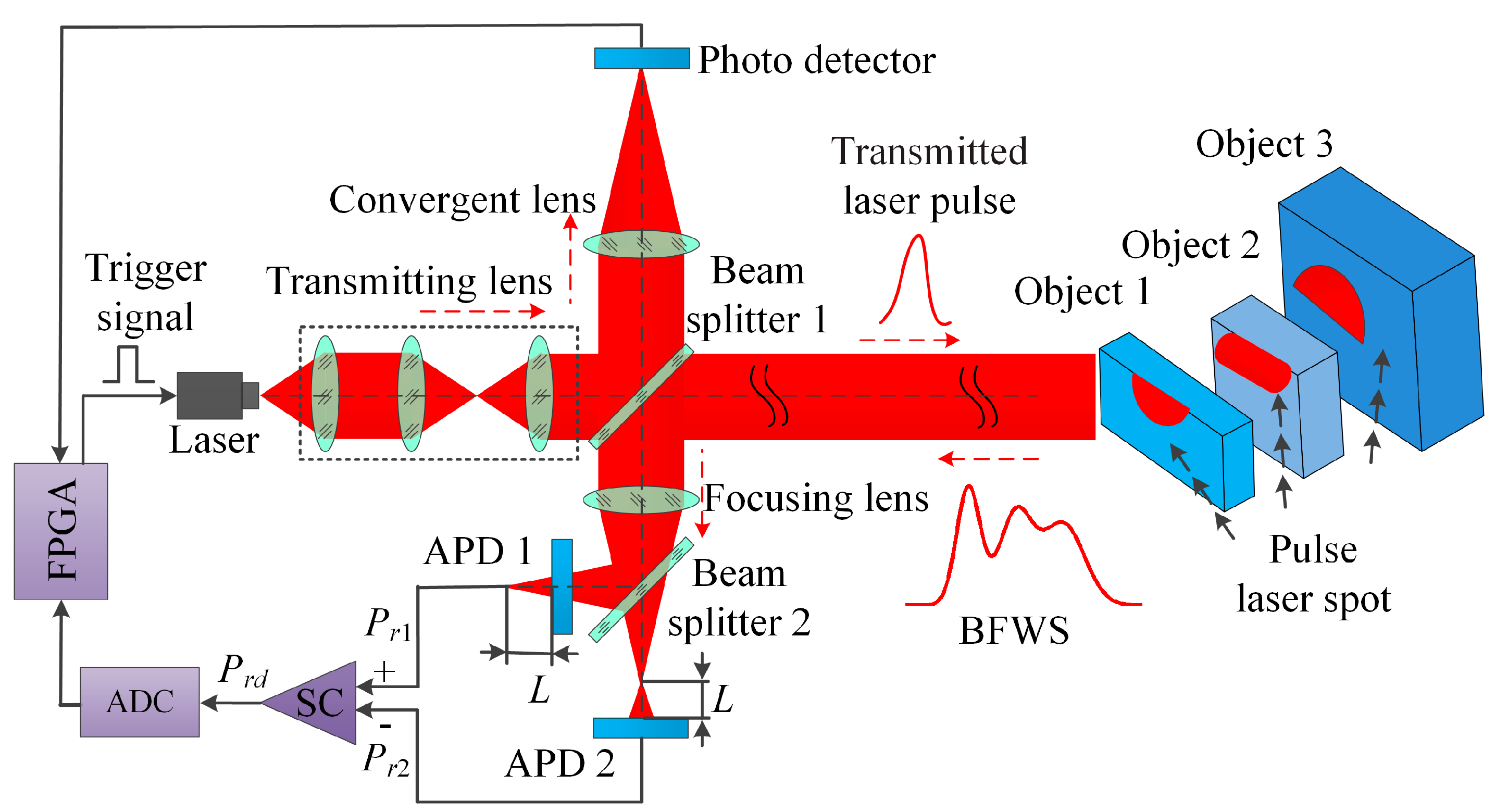
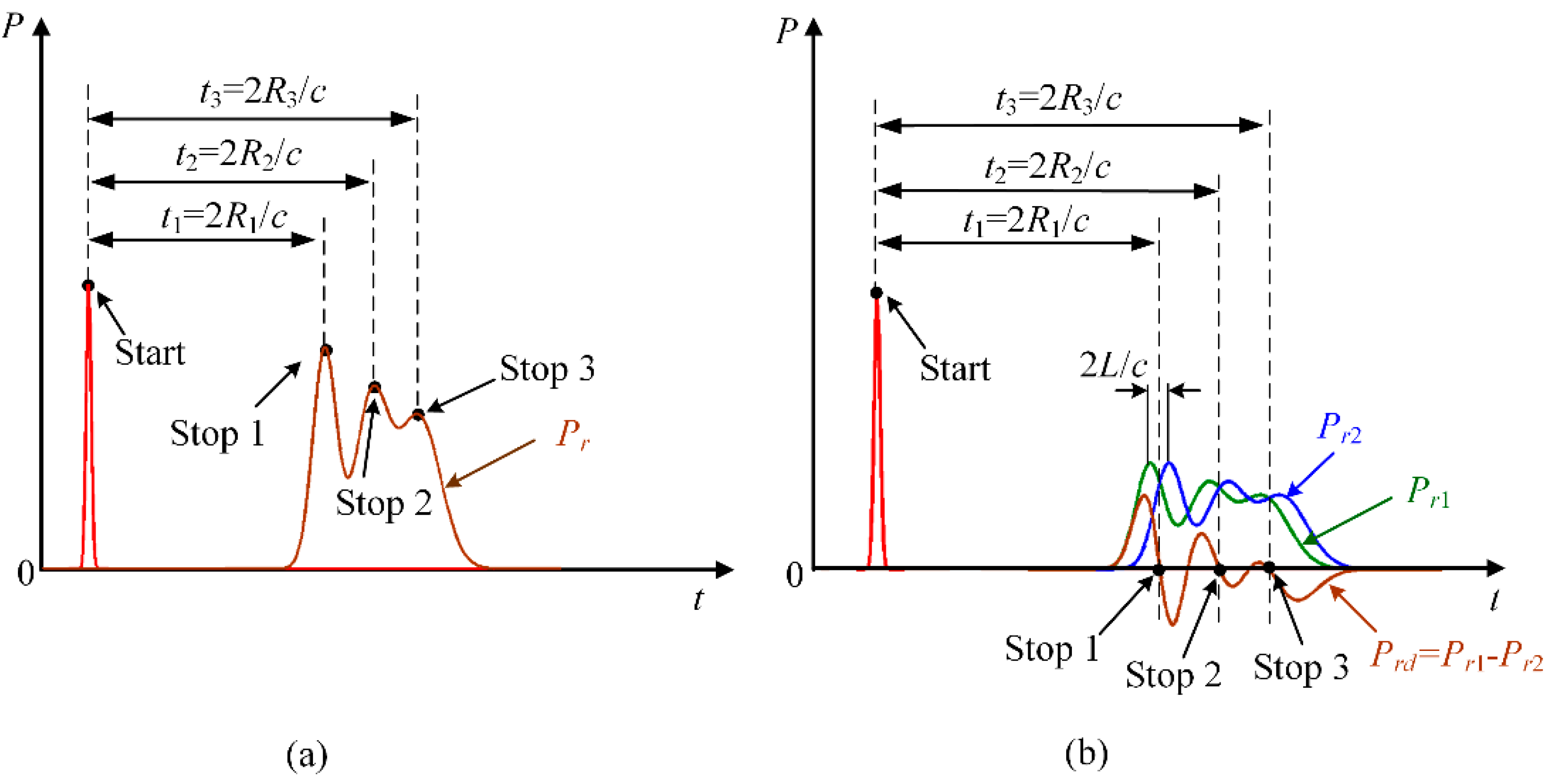

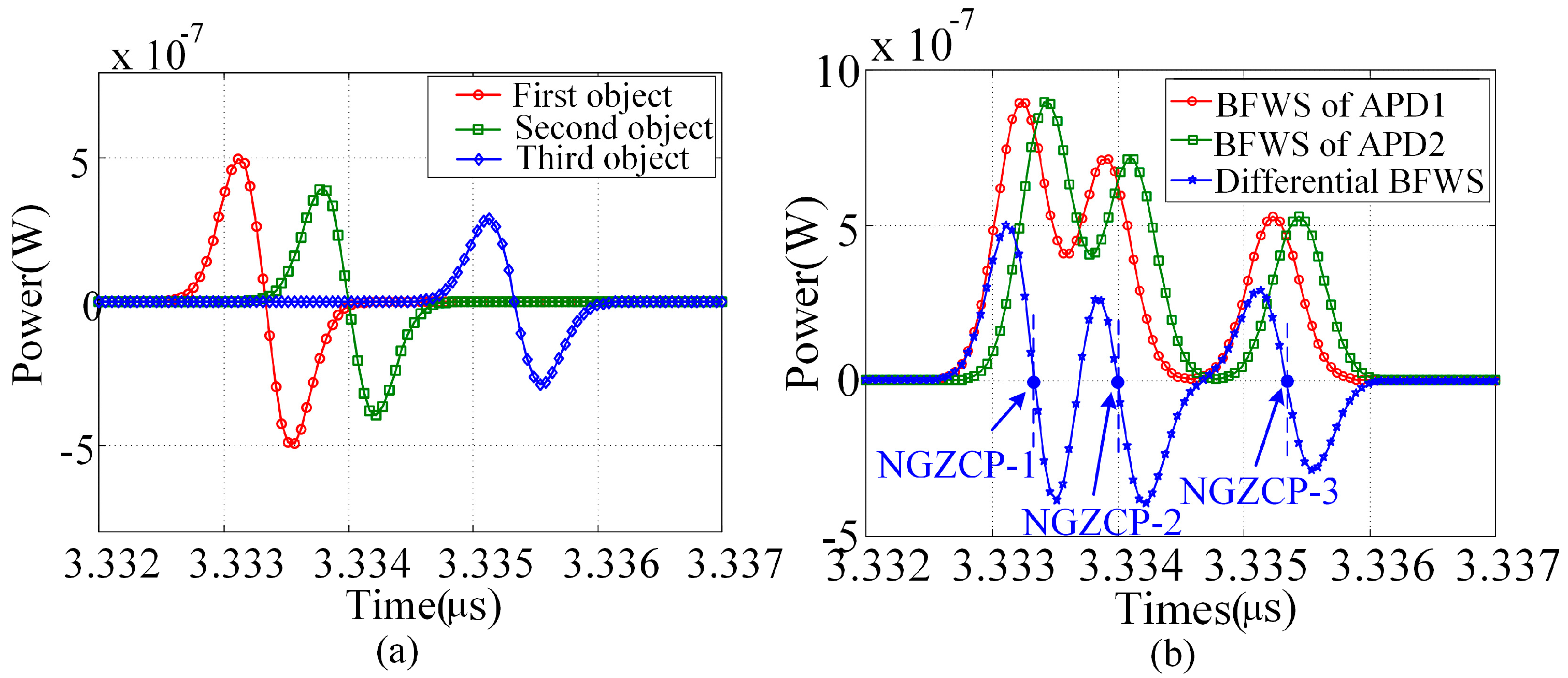

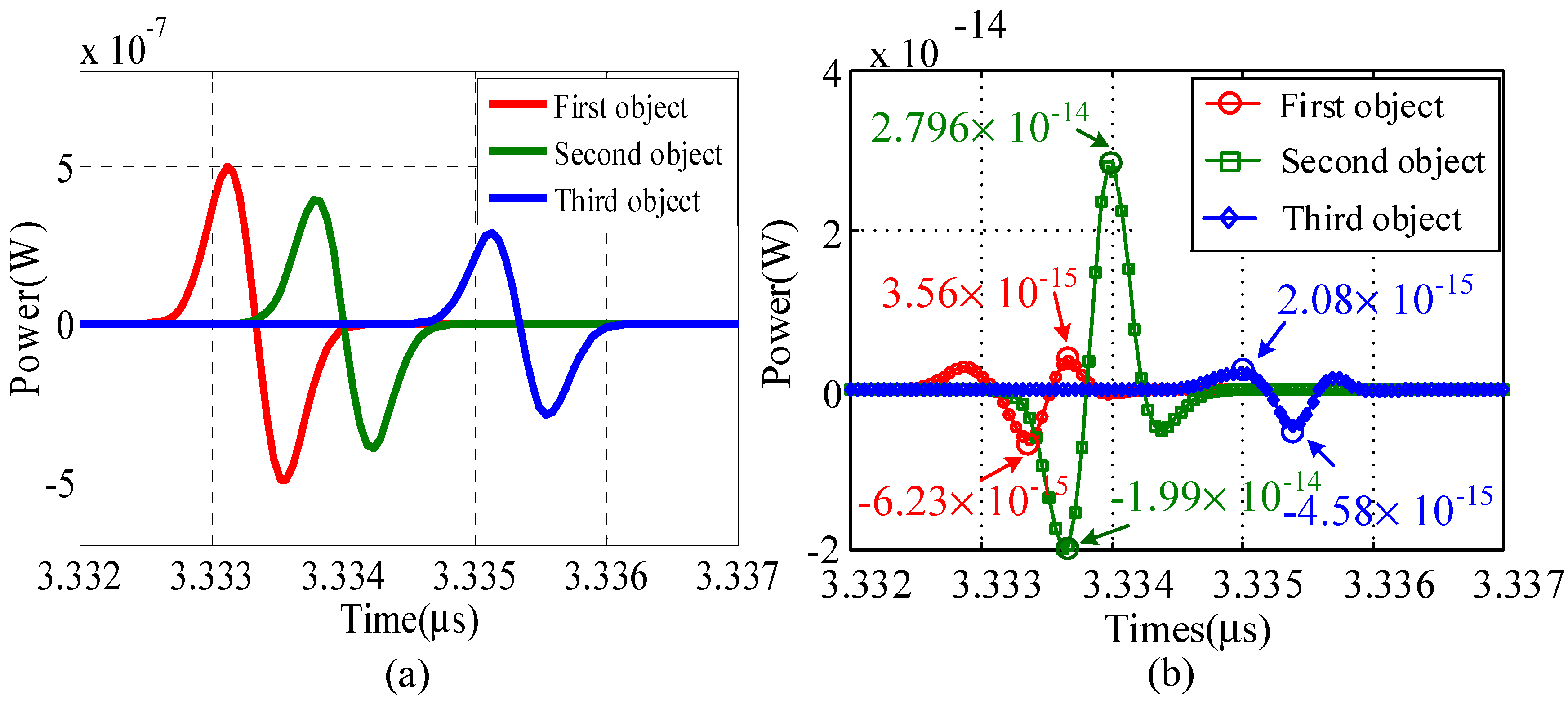
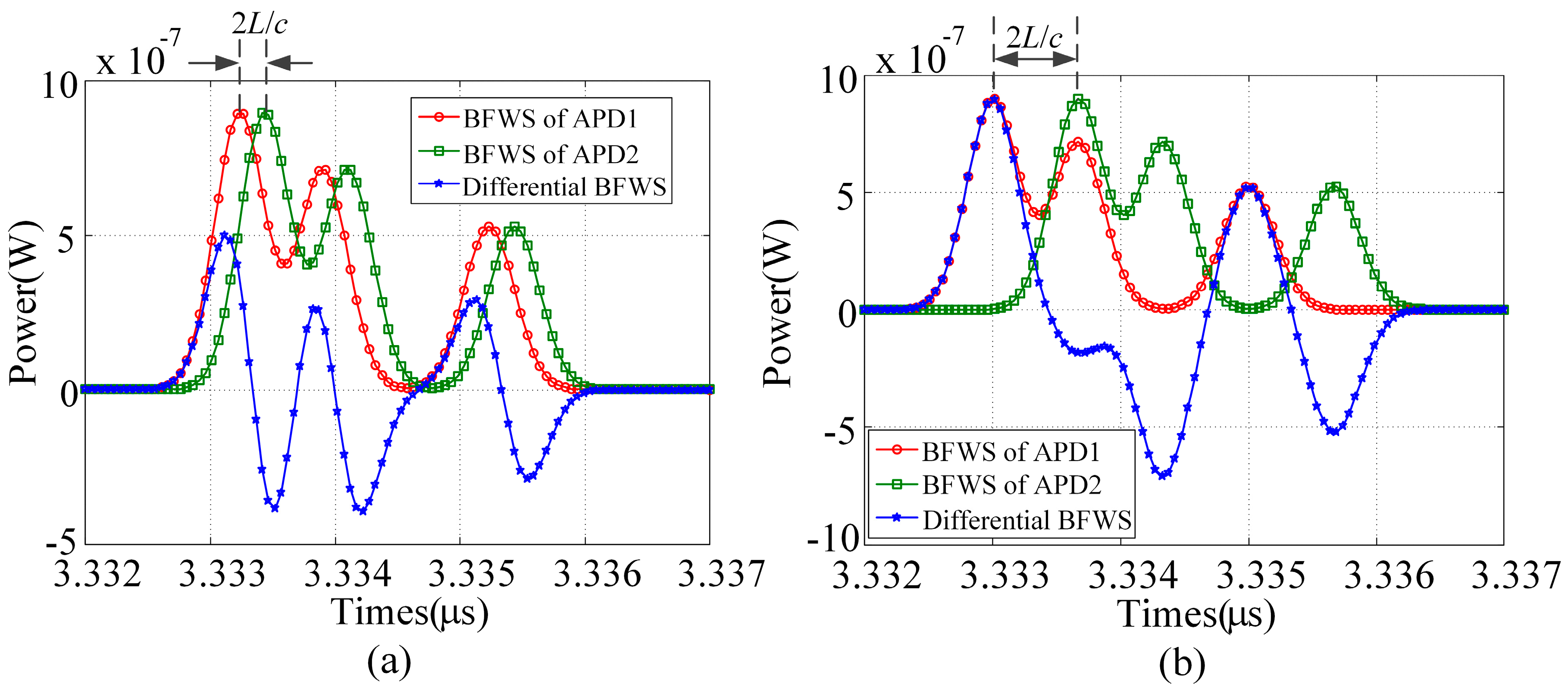
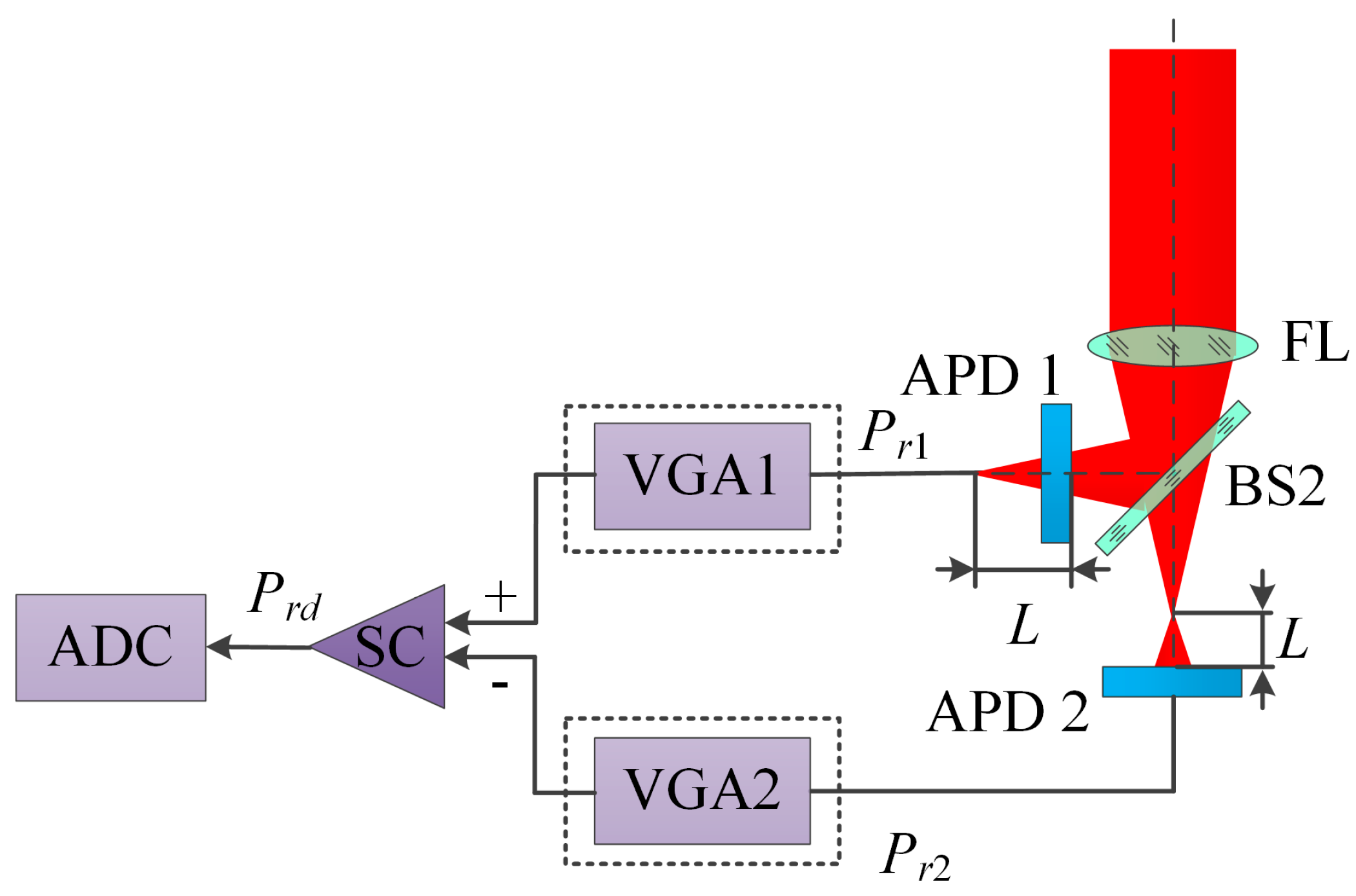
| Parameter | Value | Object | Parameter | Value |
|---|---|---|---|---|
| Original pulse energy (Et) | 4 μJ | First | Distance to laser(R1) | 500 m |
| Wavelength (λ) | 1064 nm | Reflectivity(ρ1) | 0.5 | |
| Initial beam radius (W0) | 0.02 m | Tilt angle(θ1) | 10° | |
| Initial pulse width (τ0) | 0.2 ns | Backscatter cross-section(σ1) | 0.098 | |
| Transmitter beam divergence (βt) | 0.5 mrad | Second | Distance to laser(R2) | 500.1 m |
| Aperture diameter of the receiver (Dr) | 25 mm | Reflectivity(ρ2) | 0.4 | |
| Area of the receiver (Ar) | π × Dr 2/4 | Tilt angle(θ2) | 20° | |
| Transmission of the receiver (Tr) | 0.8 | Backscatter cross-section(σ2) | 0.079 | |
| System transmission factor (ηsys) | 0.8 | Third | Distance to laser(R3) | 500.3 m |
| Atmospheric transmission factor (ηatm) | 0.9 | Reflectivity(ρ3) | 0.3 | |
| Background solar irradiance (hsum) | 500 W/m2/μm | Tilt angle(θ3) | 30° | |
| Field of view (FOV) | 5° | Backscatter cross-section(σ3) | 0.059 | |
| Optical bandwidth (Δλ) | 10 nm |
| Object | Parameter | Real Value | Differential Gaussian Fitting Value | Absolute Error | Relative Error |
|---|---|---|---|---|---|
| First | Amplitude (a1/2) | 8.9579 × 10−7 W | 8.9948 × 10−7 W | 3.64 × 10−9 W | 0.41% |
| Position (t1) | 3.33333 μs | 3.33333 μs | 0 μs | 0% | |
| Standard deviation (2 × δ12) | 8.0326 × 10−20 | 8.0383 × 10−20 | 5.7 × 10−23 | 0.07% | |
| First | Backscatter cross-section (σ1) | 0.098 | 0.0985 | 0.0005 | 0.51% |
| Second | Amplitude (a2/2) | 7.1166 × 10−7 W | 7.1723 × 10−7 W | 5.57 × 10−9 W | 0.78% |
| Position (t2) | 3.3340 μs | 3.3340 μs | 0 μs | 0% | |
| Standard deviation (2 × δ22) | 8.1389 × 10−20 | 8.1473 × 10−20 | 8.4 × 10−23 | 0.10% | |
| Second | Backscatter cross-section (σ2) | 0.079 | 0.0797 | 0.0007 | 0.89% |
| Third | Amplitude (a3/2) | 5.2655 × 10−6 W | 5.2517 × 10−6 W | 1.38 × 10−9 W | 0.26% |
| Position (t3) | 3.3353 μs | 3.3353 μs | 0 μs | 0% | |
| Standard deviation (2 × δ32) | 8.3495 × 10−20 | 8.3487 × 10−20 | 8.0 × 10−24 | 0.01% | |
| Third | Backscatter cross-section (σ3) | 0.059 | 0.0588 | 0.0002 | 0.34% |
© 2017 by the authors. Licensee MDPI, Basel, Switzerland. This article is an open access article distributed under the terms and conditions of the Creative Commons Attribution (CC BY) license (http://creativecommons.org/licenses/by/4.0/).
Share and Cite
Cheng, Y.; Cao, J.; Hao, Q.; Xiao, Y.; Zhang, F.; Xia, W.; Zhang, K.; Yu, H. A Novel De-Noising Method for Improving the Performance of Full-Waveform LiDAR Using Differential Optical Path. Remote Sens. 2017, 9, 1109. https://doi.org/10.3390/rs9111109
Cheng Y, Cao J, Hao Q, Xiao Y, Zhang F, Xia W, Zhang K, Yu H. A Novel De-Noising Method for Improving the Performance of Full-Waveform LiDAR Using Differential Optical Path. Remote Sensing. 2017; 9(11):1109. https://doi.org/10.3390/rs9111109
Chicago/Turabian StyleCheng, Yang, Jie Cao, Qun Hao, Yuqing Xiao, Fanghua Zhang, Wenze Xia, Kaiyu Zhang, and Haoyong Yu. 2017. "A Novel De-Noising Method for Improving the Performance of Full-Waveform LiDAR Using Differential Optical Path" Remote Sensing 9, no. 11: 1109. https://doi.org/10.3390/rs9111109





